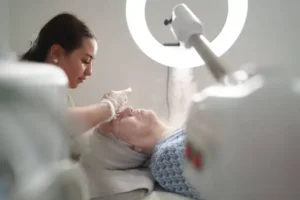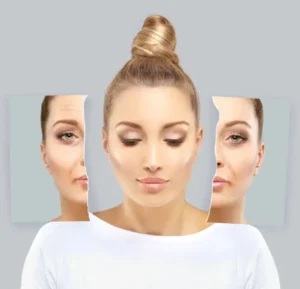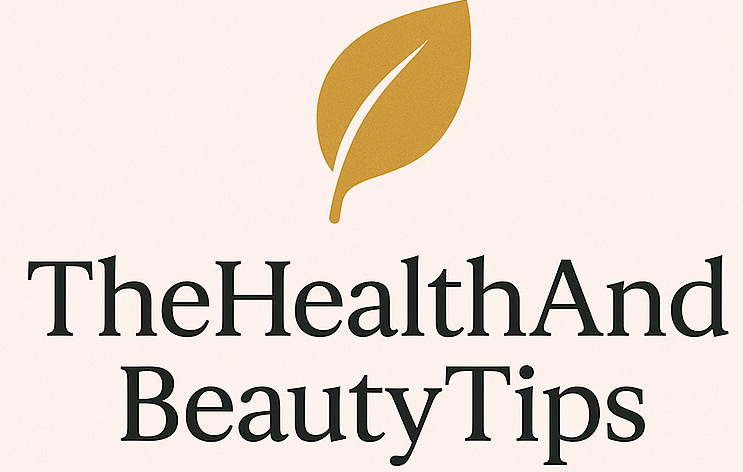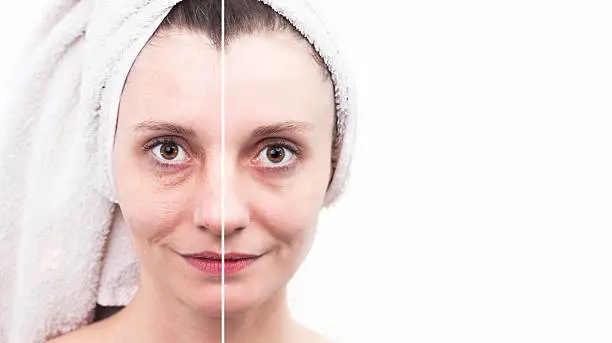Best face treatment for wrinkles in 2025
Wrinkles are a natural part of the aging process, but they can often be a source of concern for many people as they grow older. With modern skincare advancements, numerous treatments are available to minimize the appearance of wrinkles and rejuvenate the skin. Whether you’re looking for non-invasive treatments, topical products, or more intensive procedures, there’s a treatment to suit your needs and budget.
we’ll dive into the causes of wrinkles, explore the best face treatments for wrinkles, and provide answers to common questions. From skincare routines to professional treatments, we’ll cover all the options available to help you achieve smoother, youthful-looking skin.
What Causes Wrinkles?
Before delving into treatments, it’s essential to understand why wrinkles form in the first place. Several factors contribute to the formation of wrinkles, including:
- Aging: As we age, our skin naturally loses collagen and elastin, two essential proteins that keep the skin firm and elastic. This leads to sagging and wrinkling.
- Sun Exposure: Ultraviolet (UV) rays from the sun damage collagen fibers in the skin, accelerating the aging process and leading to premature wrinkles.
- Smoking: Smoking reduces blood flow to the skin and decreases the oxygen supply, leading to a dull complexion and the formation of fine lines and wrinkles.
- Facial Expressions: Repeated facial movements like squinting, frowning, or smiling can lead to the development of expression lines over time.
- Genetics: Some individuals are more predisposed to developing wrinkles earlier due to their genetic makeup.
Types of Wrinkles
Understanding the types of wrinkles you have can help determine the best treatment. The main types include:
- Dynamic Wrinkles: These wrinkles form from repeated facial movements and are typically visible when you make facial expressions (e.g., crow’s feet, frown lines).
- Static Wrinkles: These are deeper lines that remain visible even when your face is at rest, often due to the loss of skin elasticity.
- Surface Wrinkles: These are fine lines that appear on the skin’s surface and are often a result of dehydration or sun damage.
The Best Face Treatments for Wrinkles
Now, let’s explore the various face treatments available for wrinkles, broken down into categories based on their intensity and effectiveness. Best face treatment for wrinkles in 2025
Skincare Products for Wrinkles

The foundation of any anti-aging routine should include quality skincare products. There are several key ingredients known for their ability to target wrinkles and improve the skin’s texture.
Retinoids (Retinol and Retinoid Creams)
Retinoids are derivatives of vitamin A and are widely regarded as one of the most effective treatments for wrinkles. Retinol, a gentler form of retinoid, promotes cell turnover, helping to fade fine lines and wrinkles by stimulating collagen production.
- How it works: Retinoids increase the rate of skin cell turnover, which helps to shed old, damaged skin and promotes the growth of new, more youthful skin.
- Best use: Apply retinoid products in the evening, as they can make the skin more sensitive to the sun.
Hyaluronic Acid (HA)
Hyaluronic acid is a naturally occurring substance in the body that helps retain moisture in the skin. As we age, the body’s ability to produce HA decreases, leading to drier, less plump skin. Best face treatment for wrinkles in 2025
- How it works: HA holds moisture in the skin, providing hydration that fills in fine lines and wrinkles, making the skin appear plumper and smoother.
- Best use: Use a hyaluronic acid serum or moisturizer daily to combat dryness and improve skin hydration.
Peptides
Peptides are short chains of amino acids that play a crucial role in the skin’s structure. They can stimulate collagen production and improve skin elasticity, which reduces the appearance of wrinkles.
- How it works: Peptides send signals to the skin to produce more collagen and elastin, helping to repair and strengthen the skin’s barrier.
- Best use: Apply peptide-based serums or moisturizers to the skin after cleansing.
Vitamin C
Vitamin C is an antioxidant that protects the skin from free radicals and environmental stressors. It also helps brighten the skin and promotes collagen synthesis.
- How it works: Vitamin C helps reduce the appearance of wrinkles by promoting collagen production and reducing the effects of oxidative damage from UV rays and pollution.
- Best use: Apply a Vitamin C serum in the morning after cleansing.
Alpha Hydroxy Acids (AHAs)
AHAs, such as glycolic acid, are chemical exfoliants that help to remove dead skin cells and promote a smoother complexion. Regular exfoliation can reduce the appearance of surface wrinkles. Best face treatment for wrinkles in 2025
- How it works: AHAs exfoliate the top layer of the skin, removing dead cells and revealing fresher, more youthful-looking skin.
- Best use: Incorporate AHA-based products into your skincare routine 2-3 times a week.
Professional Treatments for Wrinkles

For those seeking faster or more dramatic results, professional treatments might be the way to go. These treatments are usually performed by dermatologists or licensed practitioners and can offer more immediate improvements.
Botox and Other Neurotoxins
Botox is one of the most popular treatments for dynamic wrinkles, particularly for lines caused by facial expressions. It works by temporarily paralyzing the muscles that cause wrinkles, providing smoother skin.
- How it works: Botox blocks the nerve signals that cause muscles to contract, preventing the formation of dynamic wrinkles like crow’s feet, forehead lines, and frown lines.
- Best use: Botox is typically used for fine lines and wrinkles on the upper face, such as around the eyes, forehead, and between the eyebrows.
Dermal Fillers
Dermal fillers, such as hyaluronic acid-based injections (e.g., Juvederm or Restylane), can help restore volume and smooth out deep wrinkles and folds, particularly in the lower face.
- How it works: Dermal fillers are injected into areas of the face that have lost volume, such as the cheeks, nasolabial folds, and marionette lines.
- Best use: Fillers are ideal for treating static wrinkles and restoring a youthful contour to the face.
Chemical Peels
A chemical peel involves applying a solution to the skin to remove the outer layers, revealing smoother and more even skin underneath. This treatment can be effective for reducing fine lines, sun damage, and hyperpigmentation.
- How it works: The solution exfoliates the skin, promoting collagen production and revealing a brighter complexion.
- Best use: Chemical peels are effective for mild to moderate wrinkles and can be done as a series for best results.
Laser Treatments
Laser treatments, such as fractional CO2 lasers or non-ablative lasers like Fraxel, stimulate collagen production by creating controlled damage to the skin. This leads to improved texture and reduced wrinkles.
- How it works: The laser creates tiny wounds in the skin, prompting the body to repair the damage by producing new collagen and elastin.
- Best use: Laser treatments are ideal for deep wrinkles, skin texture issues, and pigmentation problems.
Microneedling
Microneedling uses fine needles to create tiny punctures in the skin, stimulating collagen production and improving skin texture. It can be used to treat both fine lines and deeper wrinkles.
- How it works: The tiny needles create micro-injuries in the skin, which triggers the body’s healing response and collagen production.
- Best use: Microneedling is great for treating fine lines, acne scars, and overall skin texture.
Lifestyle Changes to Prevent Wrinkles

In addition to topical treatments and professional procedures, adopting a healthy lifestyle can significantly impact the appearance of your skin.
- Sun Protection: Wearing sunscreen daily is one of the most effective ways to prevent premature aging and wrinkles caused by UV rays.
- Healthy Diet: A diet rich in antioxidants, healthy fats, and vitamins can nourish your skin and keep it youthful.
- Hydration: Drinking plenty of water helps maintain skin hydration, preventing dryness and the formation of fine lines.
Conclusion: Wrinkle Treatments for Every Need
Whether you’re looking for a simple skincare routine, a non-invasive treatment, or a more intensive procedure, there are numerous ways to treat wrinkles and rejuvenate your skin. The key is to understand your skin’s needs and choose a treatment that aligns with your goals.
By combining skincare, professional treatments, and healthy lifestyle choices, you can achieve smoother, younger-looking skin. Best face treatment for wrinkles in 2025
FAQs: Common Questions About Face Treatments for Wrinkles
1. Can wrinkles be eliminated?
While no treatment can eliminate wrinkles, many options can significantly reduce their appearance and make the skin look smoother and more youthful.
2. How long do Botox results last?
Botox results typically last 3 to 6 months. After this time, you’ll need a touch-up session to maintain the results.
3. Are there any natural treatments for wrinkles?
Natural remedies such as aloe vera, coconut oil, and honey may provide some hydration and antioxidant benefits, but they are generally not as effective as clinical treatments for deeper wrinkles.
4. What is the best age to start anti-aging treatments?
It’s a good idea to start preventative anti-aging treatments in your late 20s or early 30s. However, it’s never too late to start taking care of your skin.
5. Do dermal fillers hurt?
Most dermal filler treatments involve some discomfort, but the use of a topical numbing cream can minimize pain.

